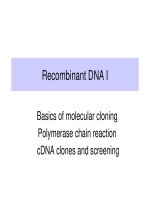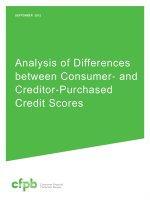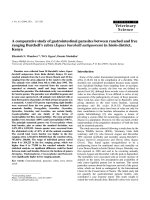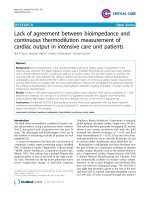Modelling of reaction between antioxidants and free radicals
Bạn đang xem bản rút gọn của tài liệu. Xem và tải ngay bản đầy đủ của tài liệu tại đây (847.19 KB, 178 trang )
MODELLING OF REACTION BETWEEN ANTIOXIDANTS
AND FREE RADICALS
T VELMURUGAN
(M.Engg. National University of Singapore)
A THESIS SUBMITTED FOR THE DEGREE OF
DOCTOR OF PHILOSOPHY
DEPARTMENT OF CHEMISTRY
NATIONAL UNIVERSITY OF SINGAPORE
2007
Dedicated
to
My Mother (late) Rajamani
i
ACKNOWLEDGEMENTS
I would like to extend numerous thanks to:
• My supervisors; Dr. Leong Lai Peng and Dr. Ryan P.A. Bettens for taking me on
as a graduate student, for all the guidance they have given me and patience they
have shown me, and for letting me broaden my horizons.
• My friends Janaka, Amar, Abul, for being a great Food Chemistry lab partners
and for being such a good influence on me.
• The best office-mates, Ms Chooi Lan and Ms Huey Lee.
• My many other friends in the Food Science Department and Department of
Chemistry, for all the fun times we’ve had together.
• Last but certainly not least, my wife, Selvi, for her strong support during PhD and
her home management skills, which helped me to concentrate on research and my
lovable sons Barath and Sanchith for their help in releasing my research work
pressure and my father Thavasi for his wishes and prayer for me. I thank them for
everything they have given me.
ii
Abstract
Radical scavenging ability (RSA) of the polyphenols was determined experimentally by
kinetic parameters (rate constants, k and activation energy E
a
) in different solvents using
the stopped-flow technique and computationally by the molecular parameter, OH bond
dissociation enthalpy (OH BDE) using density functional theory/ B3LYP method in
Gaussian 98. Kinetic study on the model phenolic compounds reveals that rate of radical
scavenging reaction of polyphenols depend not only the number and position of OHs but
also the presence of electron donating groups (EDGs) in the structure. Computational
study reveals that the presence of intramolecular hydrogen bond (IHB), which decreases
the OH BDEs of phenols. Epigallocatechin gallate (EGCG), a tea polyphenol, showed the
greater RSA (E
a
= 60.9 kJ mol
-1
against DPPH
•
).
1
TABLE OF CONTENTS
ACKNOWLEDGEMENTS i
1. GENERAL INTRODUCTION 12
1.1 Free radicals 12
1.2 Effect of free radicals on biological system 13
1.3 Effect of free radicals on food 13
1.4 Antioxidants 15
1.4.1 Primary antioxidants 15
1.4.2 Secondary antioxidants 17
1.5 Effect of antioxidant on free radicals in food & biological system 19
1.6 Mechanism of phenolic antioxidants 21
1.7 Experimental methods for antioxidant analysis 23
1.7.1 ABTS radical cation scavenging assay 23
1.7.2 Ferric Reducing / Antioxidant Power (FRAP) 24
1.7.3 Oxygen radical absorption capacity (ORAC) 25
1.7.4 Total radical-trapping antioxida
nt parameter (TRAP) method 26
1.7.5 DPPH radical sca
venging assay 27
1.8 Kinetic study of antioxidant reaction
29
1.9 Computational chemistry 34
1.9.1 Quantum mechanics calculations 34
1.9.2 Semi-empirical methods 35
1.9.3 A
b initio methods 35
1.9.4 Density functional theory (DFT) 36
2
1.9.5 Level of theory 37
1.9.6 Basis sets 37
1.9.7 Minimal basis set 38
1.9.8 Split-valence basis set 38
1.9.9 Polarization ba
sis set 39
1.9.10 Diffuse basi
s set 40
1.9.11 High angular momentum basis sets 40
1.10 Objective of the study 41
2. METHODS USED FOR STUDY 44
2.1 Rapid kinetic study 44
2.2 Instrumentation 44
2.3 General principle of experiments with the stopped-flow machine 46
2.4 Reagents 47
2.5 Kinetic method 48
2.5.1 Measurement of kinetic rate constants for the reaction of phenols with
DPPH• 48
2.5.2 Effect of temperature on phenols 52
2.5.2.1 Measurements of activation parameters 52
2.6 Computational method 53
2.6.1 Hardware det
ails 54
2.6.2 Theoretical measurement of OH BDE in gas phase 55
2.6.3 Theoretical measurement of OH BDE in solution 57
3. KINETIC STUDY ON PHENOLS 59
3
3.1 Results and discussion 61
3.1.1 Effect of 2-OH phenols 66
3.1.2 Effect of 3-OH phenols 67
3.1.3 Comparison of 2 and 3-OH phenols 68
3.1.4 Effect of solvation 72
3.2 Conclusion 78
4. COMPUTATIONAL STUDY ON PHENOLS 80
4.1 Theoretical measurement of BDE in solution 81
4.2 Results and discussion 81
4.2.1 Identification of active OH site in phenols 81
4.3 Gas phase calculations 87
4.3.1 Basis set effects on BDE calculations 87
4.3.2 Ortho (IHB) effect 94
4.3.3 Para effect 98
4.3.4 Combined effects of ortho (IHB) and para 99
4.3.5 Me
ta effect 103
4.4 Conclusion 104
5. SUBSTITUENTS EFFECT ON RADICAL SCAVENGING ABILITY OF
CATECHOL 106
5.1 Kinetics results and Discussion on substituted catechol 108
5.1.1 Effect of EDGs on the kinetics of catechol 111
5.1.2 Effect of EWGs on the
kinetics of catechol 111
5.1.3 Significance of Hammet relation 112
4
5.2 Conclusion on catechol kinetics 114
5.3 Computational study of substituted catechols 114
5.4 Computational results and discussion on substituted catechols 115
5.4.1 Effect of EDGs on OH BDE of catechol 116
5.4.2 Effect of EWGs on OH BDE of catechol 116
6. SUBSTITUENTS EFFECT ON THE RADICAL SCAVENGING ABILITY OF
PYROGALLOL 123
6.1 Results and discussion on kinetics of substituted pyrogallols 125
6.2 Computational study for substituted pyrogallols 128
6.3 Computational results and discussion for substituted pyrogallols 129
6.4 Conclusion for substituted pyrogallols 132
7. STUDY ON RADICAL SCAVENGING ABILITY OF TEA POLYPHENOLS 133
7.1 Kinetic study on radical scavenging ability of tea catechins 134
7.2 Computational study on tea catechins 140
8. OVERALL CONCLUSION 145
8.1 Conclusion on kinetic results 145
8.2 Conclusion on theoretical results 146
8.3 Future work 147
REFERENCE 148
COURSES, CONFERENCES AND PUBLICATIONS 171
APPENDIX I 173
5
ABBREVIATIONS
AAPH
2,2’-azobis(2-amidino-propane) dihydrochloride
ABAP
2,2’-azobis-(2-amidino propane) dihydrochloride
ABTS•
+
2,2’-azinobis(3-ethylbenzothiazoline-6-sulfonate
AEAC
Ascorbic acid equivalent antioxidant capacity
AO
Atomic orbital
ArO•
Antioxidant derived free radical
ArOH
Phenolic antioxidant
BDE
Bond dissociation enthalpy
DFT
Density functional theory
DNA
Deoxyribo nucleic acid
DPPH•
2,2-diphenyl-1-picrylhydrazyl radical
DTNB
5,5’-diphenyl picryl hydrazyl radical
FRAP
Ferric reducing / antioxidant power
GAE
Gallic acid equivalents
GTF
Gaussian type functions
HAT
Hydrogen atom transfer
LCAO
Linear combination of atomic orbitals
ORAC
Oxygen radical absorption capacity.
ROOH
Hydroperoxide
ROS
Reactive oxygen species
SET
Single electron transfer
STO
Slater type orbital
TAA
Total antioxidant activity.
TAC
Total antioxidant capacity.
TEAC
Trolox equivalent antioxidant capacity
TRAP
Total radical absorption power
TROLOX
6-hydroxy-2, 5,7,8-tetramethyl-2-carboxylic acid
TST
Transition state theory
6
LIST OF FIGURES
Figure 1.1: An illustration of primary antioxidant mechanism 16
Figure 1.2: Classes of polyphenols 18
Figure 1.3: Schematic representation of antioxidant m
echanism in food and biological
system. 20
Figure 1.4: Formation of ABTS radical cation on oxidation by potassium
persulfate 24
Figure 1.5: Structures of DPPH• and DPPHH 28
Figure 3.1: Basic structure of flavonoids 59
Figure 3.2: Phenols on the basis of number and position of OHs 61
Figure 3.3: Arrhenius plots for catechol (2-OHs ortho phenol) in solvents 66
Figure 3.4: Arrhenius plots for pyrogallol (3-OHs ortho phenol) in solvents
66
Figure 3.5: Intramolecular hydrogen bond (IHB) exerted stability of aroxyl radical
derived from (a) catechol, (b) pyrogallol and (c) 1,2,4-benzenetriol 69
Figure 3. 6: Activation enthalpy and entropy compensation for (a) phenolics with 2-OHs
and (b) 3-OHs. 71
Figure 3.7: Plot of experimental activation energy E
a
with respect to solvents 72
Figure 3.8: Polar protic solvent effects on both parent phenols and radical
74
Figure 3.9: Possible ortho and polar protic solvent (methanol) interactions on pyrogallol
75
Figure 3. 10: Possible polar protic solvent interactions on 1,2,4-benzenetriol
75
7
Figure 3.11: Possible polar protic solvent interactions on catechol 76
Figure 3.12: Radical scavenging ability of phenols under aprotic acetonitrile, acetone and
apolar THF 77
Figure 4.1: BDEs (kJ mol
-1
) using B3LYP/6-31 G(d) for phenol and radical 82
Figure 4.2: BDEs (kJ mol
-1
) using B3LYP/6-31 G(d) for catechol and radical 82
Figure 4.3: BDEs (kJ mol
-1
) using B3LYP/6-31 G(d) for resorcinol and radical 83
Figure 4.4: BDEs (kJ mol
-1
) using B3LYP/6-31 G(d) for hydroquinone and radical 84
Figure 4.5: BDEs (kJ mol
-1
) using B3LYP/6-31G(d) for phloroglucinol and radical 84
Figure 4.6: BDEs (kJ mol
-1
) using B3LYP/6-31 G(d) for pyrogallol and radical. 85
Figure 4.7: BDEs (kJ mol
-1
) using B3LYP/6-31 G(d) for 1,2,4-benzenetriol and radical 86
Figure 4.8: Plot of computed gas phase OH BDE with respect to basis sets 89
Figure 4.9: IHB effects on phenol and catechol (values above and below arrows are
changes in BDE in kJ mol
-1
) 94
Figure 4.10: Two IHB effects on resorcinol (the value below the arrow is the change in
BDE in kJ mol
-1
) 96
Figure 4.11: Two IHB effects on phloroglucinol (the value below the arrow is the change
in BDE in kJ m
ol
-1
) 96
Figure 4.12: One IHB effect on resorcinol (the value below the arrow is the change in
BDE in kJ mol
-1
) 97
Figure 4.13: One IHB effect on hydroquinone (the value below the arrow is the change in
BDE in kJ mol
-1
) 97
8
Figure 4.14: Para effect on phenol (the value below the arrow is the change in BDE in kJ
mol
-1
) 98
Figure 4.15: Combined effects of phenol to 1,2,4-benzenetriol (the value below the arrow
is the change in BDE in kJ mol
-1
) 99
Figure 4.16: Combined effects of phenol to 5-hydroxypyrogallol (the value below the
arrow is the change in B
DE in kJ mol
-1
) 100
Figure 5.1: Identification of catechol compound in the structure of flavonoids 107
Figure 5.2: Substituents in the catechol moiety 107
Figure 5.3: Arrhenius plot for EWG substituted catechols with DPPH
•
110
Figure 5.4: Arrhenius plot for EDG substituted catechols with DPPH
•
110
Figure 5.5: Correlation between the E
a
of substituted catechols and Hammett parameter
σ
p
113
Figure 5. 6: Stable arrangement of radical from substituted catechol 114
Figure 5.7: Canonical forms (I, II, III and IV) of phenoxyl radical 117
Figure 5.8: Correlation between the O-H BDE of substituted catechols and Ha
mmett
parameter σ
p
118
Figure 5.9: Correlation between rate constan
t at 25 °C and OH BDE of substituted
catechols 121
Figure 6.1: Importance of pyrogallol model compound in the structure of flavonoids 124
Figure 6.2: Substituents in pyrogallol moiety 124
9
Figure 6.3: Arrhenius plot for gallic acid, methyl gallate and ethyl gallate against DPPH
•
in methanol 126
Figure 6.4: Correlation between E
a
and OH BDE of substituted pyrogallols 131
Figure 7.1: Segmented structure of EC (a) EC, EGC (b), and EGCG (c)…………… 134
Figure 7.2: Arrhenius plot for EC, EGC, and EGCG reaction with DPPH
•
………….138
Figure 7.3: Calculated OH BDEs of epicatechin (EC) using B3LYP/6-31G(d)……….139
Figure 7.4: Radical scavenging mechanism of epicatechin (EC)………………………140
Figure 7.5: Calculated OH BDEs of epigallocatechin (EGC) using B3LYP/6-31G(d) 141
Figure 7.6: Radical scavenging mechanism of epigallocatechin (EGC)……………….142
10
LIST OF TABLES
Table 2.1: Phenol-radical concentration ratio for the kinetic study 49
Table 3.1: Rate constants (k), activation Energy (E
a
) of phenolics with 2-OHs in solvents
62
Table 3.2: Rate constants (k), activation Energy (E
a
) of phenolics with 2-OHs in solvents
63
Table 3.3: Activation enthalpy (∆H
#
), and entropy (∆S
#
), free energies of activation (∆G
#
)
of phenolics with 2-OHs in solvents 64
Table 3.4: Activation enthalpy (∆H
#
), and entropy (∆S
#
), free energies of activation (∆G
#
)
of phenolics with 3-OHs in solvents 65
Table 4.1: B3LYP gas-phase OH BDEs (kJ mol
-1
) as a function of basis sets 88
Table 4.2: Comparison of bond length (Å) of optimized phenol in gas phase with
experimental and other theoretical methods 91
Table 4.3: Comparison of bond length (Å) of optimized phenoxide radical in gas phase
with experimental and other theoretical methods 92
Table 4.4: B3LYP/ /6-311++G(3df, 3pd) gas phase BDEs (in kJ mol
-1
) for phenols 93
Table 4.5: Calculated OH BDEs (kJ mol
-1
) of phenol, catechol, resorcinol, hydroquinone
using SCRF/ B3LYP/6-311++G (3dp, 3df) 101
Table 4. 6: Calculated solvent-Phas
e OH BDEs (kJ mol
-1
) of phloroglucinol, pyrogallol
and 1,2,4-benzenetriol using SCRF/ B3LYP/6-311++G (3dp, 3df) 102
11
Table 5.1: Hammet constant for the para substitution groups 108
Table 5.2: Rate constants (k), activation energy (E
a
) of substituted catechols in methanol
109
Table 5.3: Effect of para substitutions on the (O
2
-H
2
) BDE of catechols 115
Table 6.1: Rate constants (k), activation energy (E
a
) of substituted pyrogallols in
methanol 127
Table 6.2: Comparison of substituted pyrogallols activation energy with the pyrogallol
127
Table 6.3: (O
2
-H
2
) BDE of substituted pyrogallols 130
Table 7.1: Rate constants (k), activation Energy (E
a
) of tea polyphenols against DPPH
•
in methanol…………………………………………………………………………… 134
Table 7.2: Effect of moiety P present in the tea catechins…………………………… 137
Table 7.3: OH BDEs of tea catechins using B3LYP/6-31G(d) in gas phase study…….141
12
1. GENERAL INTRODUCTION
While manufacturers of nutritional supplements have been fortifying foods with
traditional vitamins and minerals, branding them as “nutraceuticals’, future trends seems
to be pointing to the direction of neutraceuticals being supplemented with ingredients that
can also help maintain wellness and prevent diseases. United States alone spent
approximately $22.6 billion on nutritional supplements with an expected market value of
$35.4 billion by year 2006. Within the nutraceutical category are antioxidants, essential
compounds needed for controlling degenerative oxidation reactions caused by reactive
oxygen and nitrogen species (ROS & RNS) in living tissues as well as in the inhibition of
lipid peroxidation in foods. In recent years, there has been a growing interest in
identifying potentially important antioxidants against free radicals, especially those from
naturally occurring substances. Recently, harmless natural plant products have been an
important source for the search of new antioxidants, by both nutraceuticals and
pharmaceutical companies.
1.1 Free radicals
A free radical is any species that contains one or more unpaired electrons and is capable
of independent existence. Such a radical can attach itself to a stable molecule within the
body and damaging the surrounding cells. Most of the radicals are reactive oxygen
species (ROS) formed during normal cell aerobic respiration (Gutteridge and Halliwell,
2000). ROS are oxygen derived chemically reactive molecules (Fridovich, 1999;
Betteridge, 2000; Halliwell, 1999; Halliwell, 1996). The major ROS present in the cells
are superoxide, hydrogen peroxide, hydroxyl radical, and nitric oxide. Superoxide anions
13
are formed by an electron addition to the molecular oxygen. Superoxide anions are not as
reactive as other ROS. The hydroxyl radical is very reactive compared with other
radicals. The hydroxyl radical is formed from hydrogen peroxide in a reaction known as
Fenton reaction that is catalyzed by metal ions (Fe
2+
or Cu
2+
) (Halliwell, 1999 & 1987).
1.2 Effect of free radicals on biological system
The high reactivity of reactive oxygen species (ROS) induces damage in lipids, DNA,
and proteins (Blokhina et al., 2003; Werns and Lucchesi, 1989; Auroma, 1994;
Kirkinezos and Moraes, 2001; Lee and Wei, 2001). They oxidize important components
of cell and cause permanent damage. Radicals are capable of reacting with any
biomolecule in the living cell (Halliwell, 1989). ROS are found to be mutagenic. Free
radical also induces structural changes in DNA leading to cancer and other diseases
(Marnett. 2000; Mates et al., 1999). Free radical reactions mainly contribute to
atherosclerosis, ageing, cancer, diabetes mellitus, inflammation, AIDS, and severe
degenerative diseases in humans (Halliwell, 1997; Giblin, 1985; Keller, 1998; Halliwell,
1999; Prasad, 1999 and Pratico, 2000). Lipid peroxidation is another process that
produces many pathological events in the cells (Halliwell and Gutteridge, 1999b;
Noguchi and Niki, 1999; Drueke et al., 2001 and Spiteller, 2001). This process causes
damage to unsaturated fatty acids, tends to decrease membrane fluidity and lead to many
other pathological events.
1.3 Effect of free radicals on food
One of the most common causes of off-flavors and odors in many foods is lipid oxidation
(Eriksson, 1987). Lipid oxidation occurs through either an enzymatic or non-enzymatic
14
mechanism. Both mechanisms yield hydroperoxides, which then break down to form a
number of volatile compounds that are responsible for off-flavors and odors. Enzyme-
catalyzed oxidation, as the name implies, must be initiated by an enzyme, such as
lipoxygenase, acyl hydrolase, or hydroperoxide lyase (Nawar, 1996). Autoxidation,
however, does not require enzymatic catalysis. Once the process is initiated, it is “self
catalyzing” as long as there is molecular oxygen present. The mechanism of autoxidation
of lipids involves the three stages: initiation, propagation and termination.
Initiation RH
Æ
R
•
Eqn 1. 1
R'-CH=CH-R'' + O
2
Æ
ROOH Eqn 1. 2
Propagation R • + O
2
Æ
ROO
•
Eqn 1. 3
ROO • + RH
Æ
ROOH + R
•
Eqn 1. 4
ROOH
Æ
RO
•
+ OH
•
Eqn 1. 5
Termination R• + R •
Æ
Non radical products Eqn 1. 6
ROO • + ROO
•
Æ
R1-CO-R2 + R1-CHOH-R2 + O2 Eqn 1. 7
The initiation step is the most intriguing aspect of this chemical process. The spontaneous
abstraction of a hydrogen atom from an organic material by molecular oxygen (equation
1.1) is an endothermic reaction which demands large activation energy and although it
might occur to a certain extent, it is probably too slow to be of practical importance.
Alternatively, the direct addition of an oxygen molecule to a double bond to generate
hydroperoxide (ROOH) compounds is prevented by the spin conservation rule due to the
triplet state character of the ground state oxygen. Therefore, either the organic molecule
or the oxygen should be activated before reaction. Many foods are now being packed in
15
plastic containers that have significant oxygen permeability. This can lead to an increase
in autoxidation as oxygen migrates into the container. In addition, foods that have high
concentrations of fatty acids, especially polyunsaturated fatty acids, are more susceptible
to lipid oxidation.
1.4 Antioxidants
Halliwell (1995) defined an antioxidant as any substance that when present at low
concentrations compared with those of an oxidizable substrate significantly delays or
prevents oxidation of that substrate. The term oxidizable substrate here refers to
biological molecules that are found in the body or fats that are present in food.
Antioxidants can be classified in a different manner according to their activity. Based on
the mechanism of reactions, antioxidants are classified into primary antioxidants and
secondary antioxidants.
1.4.1 Primary antioxidants
Free radicals can attach themselves into an oxidizable substrate and cause the damage.
After the stable molecule (substrate) loses its electron it becomes a free radical and
begins a chain reaction. Primary antioxidants are the ones that inhibit the chain initiation,
and break chain propagations. They delay or prevent oxidation of the substrate from
acting as a chain-propagating radical, hence called chain breaking antioxidants. For
example, secondary aromatic amines are primary antioxidants that react with peroxyl
radicals to form stable hydroperoxides by donating their hydrogen atom.
16
N
H
R'
+ ROO
N R'
+ ROOH
Secondary amine Peroxyl radical
Stable amine radical Stable
product
Figure 1.1: An illustration of primary antioxidant mechanism
Among many classes of primary antioxidants, polyphenols are probably the most widely
studied antioxidants in biochemical systems (Halliwell, 1999; Burton, 1986; Noguchi,
2000; Denisov, 2000). The term polyphenols embraces a wide range of plant substances
that possess an aromatic ring bearing one or more hydroxyl substituents (Lazarus et al.,
2001). Literatures report that the lipid oxidation can be effectively quenched by
polyphenols (Periera da Silva et al., 2000; Czinner et al., 2001 & Lodovici et al., 2001),
which are also known to be scavengers of various oxygen species, even as toxic as the
HO• radical and singlet oxygen (Croft, 1998 & Morton et al., 2000). Phenolic
antioxidants (ArOH) have recently attracted increasing interest in pharmaceutical and the
food industries (Richelle et al., 2001). The flavanoids are the largest group of phenolic
compounds. As shown in Figure 1.2, flavonoids are divided into sub classes; they are
flavones, flavanones, isoflavones, flavonols, flavanols, and anthocyanins (Rice-Evans
and Miller, 1997). Examples of natural phenolic antioxidants that belongs to flavonoids
are 3, 4-dihydroxychalcones (e.g. butein, okanin), flanones (e.g. luteolin, isovitexin),
anthocyanins (e.g. cyanidin-3-glucoside, malvidin-3-glucoside), isoflavones (e.g.
daidzein, genistein), dihydroflavonols (e.g. dihydroquercetin), flavonols (e.g. gossypetin),
cinnamic acids, ferulic acid, and caffeic acid.
17
1.4.2 Secondary antioxidants
Secondary antioxidants are different from chain-breaking antioxidants in that they react
with lipid peroxides. While chain-breaking antioxidants react with radicals and donate
an electron or hydrogen atom to reduce the radicals, secondary antioxidants are not
involved in reaction with radicals or donation of electrons. Secondary antioxidants react
with lipid peroxides (LOOH) through non-radical processes like reduction or hydrogen
donation and convert them into stable end products like alcohols. Thiols (RSH) such as
cysteine and gluthathione, sulphides (R-S-R) such as methionine and 3,3’-
thiodipropionic acid and free amine groups of proteins (R-NH
2
) react with lipid
peroxides and form stable products as given by equations below (Yanishlieva-
Maslarova, 2001).
RSH + LOOH
Æ
R-S-S-R + LOH + H
2
O Eqn 1. 8
R-S-R + LOOH
Æ
R-SO-R + LOH Eqn 1. 9
R-NH
2
+ LOOH
Æ
R-N (OH) L + H
2
O Eqn 1. 10
18
O
R
1
R
2
OH
HO
O
R
1
R
2
OH
HO
OR
4
R
3
Flavanones
R
1
,
R
2
= H, OH, OCH
3
Predominant in citrus
Flavanols
Flavanones, Flavonones, and Flavanols
AC
B
A
C
B
O
O
O
B
CA
Flavonones
R
1
-
R
4
= H, OH, OCH
3
Vegetables, herbs, teas
OH
R
2
R
1
O
R
3
R
4
R
2
O
Isoflavones
AC
O
R
3
HO
R
1
B
Chrysophanol
Caffeic acid
OH
OH
Other Polyphenols
HO
O
O
O
OH OH
CH
3
O
OH
OCH
3
H
3
CO
HO
O
Curcumin
Figure 1.2: Chemical Struture of different types of polyphenols
19
O
R
1
OH
OH
HO
OH
R
2
Anthocyandins R
1
R
2
Anthocyandins
A
C
B
Cyanidin H OH
Delphinidin OH OH
Malvidin OCH
3
OCH
3
Pelargonidin H H
Petunidin OCH
3
OH
Peonidin OCH
3
H
Figure 1.3: Chemical Struture of different types of polyphenols
1.5 Effect of antioxidants on free radicals in food and biological system
Free radicals initiate oxidation of lipids in food systems and leads to the development of
rancidity, protein damage, and oxidation of pigments causing a loss of sensory properties,
nutritive value, and shelf life of food products (Madhavi et al., 1996). The antioxidants in
foods increase their shelf-life by preventing lipid peroxidation, thereby maintaining
freshness in foods for a long time. They can be incorporated into dairy products, and
other food products. Natural antioxidants currently used include ascorbic acid, citric acid,
and α-tocopherol. Some synthetic antioxidants that are commonly used are butylated
hydroxyanisole (BHA), butylated hydroxytoluene (BHT), tertiary butylhydroquinone
(TBHQ), and propyl gallate (PG) (Nawar, 1996). In recent times there has been an
20
increase in the use of antioxidants in the food industry, not only to increase the shelf life
of foods but also as dietary supplements.
In principle, the antioxidant is to prevent the biological molecules from food or in vivo
depends on its ability to scavenge the radical before it has the opportunity to react with
them (Figure 1.3). For example, α-tocopherol (α-TOH), the most effective lipid-soluble
chain-breaking antioxidant, reacts with peroxyl radical at a rate constant of about 10
6
M
-
1
s
-1
, which is much faster than the reaction of peroxyl radicals with lipid substrate,
typically 10
1
M
-1
s
-1
(Ou, 2002).
R
RH
RH
k
1
k
2
BH
B
A
AH
BH = Biologically important molecule
AH = Antioxidant
R = Reactive radical
k
1
, k
2
=Rate constants for reaction 1 and reaction 2
[AH]k
1
>> [BH]k
2
1
2
Figure 1.4: Schematic representation of antioxidant mechanism in food and
biological systems.
21
There is a continuous search for foods rich in antioxidants. Antioxidant phytochemicals
in foods especially in vegetables, fruits, and grains are found to have human disease
prevention abilities, and may improve food quality (Yu et al., 2002). Endogenous
antioxidants, such as glutathione present in living cells, alone cannot completely prevent
the damaging effects of free radicals (Simic, 1988). Therefore, there is a need for
exogenous antioxidants (e.g. antioxidants from natural sources) that are widely available
from food. Polyphenols are natural antioxidants.
The importance of antioxidants in prevention of diseases and as promoters of good health
is widely recognized and studied. Antioxidants are effective in prevention of degenerative
illnesses, such as cancers, cardiovascular and neurological diseases, cataracts, and
oxidative stress disfunctions (Riemersma et al., 1991; Ames et al., 1993; Riemersma,
1994; Halliwell, 1996; Schwartz, 1996). Vitamin E, a natural antioxidant shows
anticarcinogenic properties because it prevents lipid oxidation and scavenges radicals
(Gaby & Machlin, 1991).
1.6 Mechanism of phenolic antioxidants
Phenolic antioxidants are excellent candidates as free radical chain terminators because
their radical intermediates, ArO
•
are relatively stable due to delocalization of the
unpaired electron into the aromatic ring (Shahidi and Wanasundara,1992). There are
arguments in the literature over the specific ways by which antioxidant mechanism of
polyphenols follow. Several researchers claim that phenols donate hydrogen atoms from
the phenolic group (Barclay and Vinqvist, 2000; Khopde et al., 1999; Masuda et al.,









